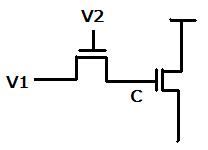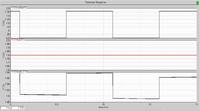MammPp
Junior Member level 2
Dear All,
I have some question about floating node. As the following picture,
If I set V1 to be Vdd all the time.
and V2 is Vdd at the first period, then set V2 is 0 (Which is close NMOS)
My question is, what is the value of the voltage at node C ?
and if V2 is zero, the other transistor, which node C is gate of them, is on/off ?
Thank you so much for your help
MammPp

I have some question about floating node. As the following picture,
If I set V1 to be Vdd all the time.
and V2 is Vdd at the first period, then set V2 is 0 (Which is close NMOS)
My question is, what is the value of the voltage at node C ?
and if V2 is zero, the other transistor, which node C is gate of them, is on/off ?
Thank you so much for your help
MammPp

